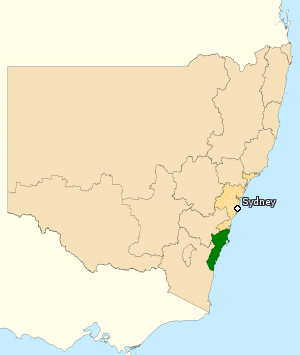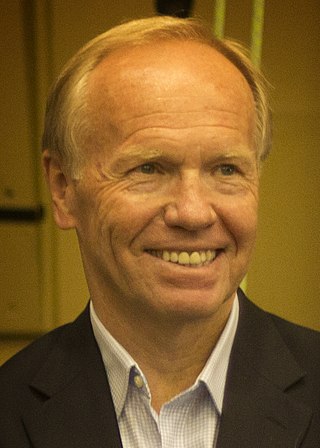
The Australian Democrats is a centrist political party in Australia. Founded in 1977 from a merger of the Australia Party and the New Liberal Movement, both of which were descended from Liberal Party splinter groups, it was Australia's largest minor party from its formation in 1977 through to 2004 and frequently held the balance of power in the Senate during that time.

The 1996 Australian federal election was held to determine the members of the 38th Parliament of Australia. It was held on 2 March 1996. All 148 seats of the House of Representatives and 40 seats of the 76-seat Senate were up for election. The Liberal/National Coalition led by Opposition Leader John Howard of the Liberal Party and coalition partner Tim Fischer of the National Party defeated the incumbent Australian Labor Party government led by Prime Minister Paul Keating in a landslide victory. The Coalition won 94 seats in the House of Representatives, which is the largest number of seats held by a federal government to date, and only the second time a party had won over 90 seats at a federal election.

The Liberal–National Coalition, commonly known simply as the Coalition or the LNP, is an alliance of centre-right to right-wing political parties that forms one of the two major groupings in Australian federal politics. The two partners in the Coalition are the Liberal Party of Australia and the National Party of Australia. Its main opponent is the Australian Labor Party (ALP); the two forces are often regarded as operating in a two-party system. The Coalition was last in government from 2013 to 2022. The group is led by Peter Dutton, who succeeded Scott Morrison after the 2022 federal election.

The Division of Gilmore is an Australian electoral division in the state of New South Wales.
This is a list of members of the Australian House of Representatives from 1996 to 1998, as elected at the 1996 federal election.
This is a list of members of the Australian Senate from 1996 to 1999. Half of the state senators had been elected at the March 1993 election and had terms due to finish on 30 June 1999; the other half of the state senators were elected at the March 1996 election and had terms due to finish on 30 June 2002. The territory senators were elected at the March 1996 election and their terms ended at the next federal election, which was October 1998.

Marrickville was an electoral district of the Legislative Assembly in the Australian state of New South Wales. It was an urban electorate in Sydney's inner west, centred on the suburb of Marrickville from which it took its name. At the time of its abolition it also included the suburbs of Camperdown, Darlington, Enmore, Lewisham, Newtown, Petersham, Stanmore and parts of Dulwich Hill and Erskineville as well as the University of Sydney.

Lang Labor was a faction of the Australian Labor Party (ALP) consisting of the supporters of Jack Lang, who served two terms as Premier of New South Wales and was the party's state leader from 1923 to 1939. It controlled the New South Wales branch of the ALP throughout most of the 1920s and 1930s. The faction broke away to form separate parliamentary parties on several occasions and stood competing candidates against the ALP in state and federal elections.

An election was held in the Australian state of Queensland on 9 September 2006 to elect the 89 members of the state's Legislative Assembly, after being announced by Premier Peter Beattie on 15 August 2006.

The 2007 New South Wales state election was held on Saturday, 24 March 2007. The entire Legislative Assembly and half of the Legislative Council was up for election. The Labor Party led by Morris Iemma won a fourth four-year term against the Liberal-National coalition led by Peter Debnam.
John Vance Langmore is an Australian academic and politician. He was a member of the Australian House of Representatives from 1984 to 1996.

The 1983 Australian federal election was held in Australia on 5 March 1983. All 125 seats in the House of Representatives and all 64 seats in the Senate were up for election, following a double dissolution. The incumbent Coalition government which had been in power since 1975, led by Malcolm Fraser and Doug Anthony, was defeated in a landslide by the opposition Labor Party led by Bob Hawke.

The 1977 Australian federal election was held in Australia on 10 December 1977. All 124 seats in the House of Representatives and 34 of the 64 seats in the Senate were up for election.

The 1972 Australian federal election was held in Australia on 2 December 1972. All 125 seats in the House of Representatives were up for election, as well as a single Senate seat in Queensland. The incumbent Liberal–Country coalition government, led by Prime Minister William McMahon, was defeated by the opposition Labor Party led by Gough Whitlam. Labor's victory ended 23 years of successive Coalition governments that began in 1949 and started the three-year Whitlam Labor Government.

The 2002 Cunningham by-election was held in the Australian electorate of Cunningham in New South Wales on 19 October 2002. The by-election was triggered by the resignation of the sitting member, the Australian Labor Party's Stephen Martin on 16 August 2002. The writ for the by-election was issued on 16 September 2002.
The 1996 Blaxland by-election was held in the Australian electorate of Blaxland in New South Wales on 15 June 1996. The by-election was triggered by the resignation of the sitting member, the Australian Labor Party's Paul Keating on 23 April 1996. The writ for the by-election was issued on 13 May 1996.

The 2011 New South Wales state election held on Saturday, 26 March 2011. The 16-year-incumbent Labor Party government led by Premier Kristina Keneally was defeated in a landslide by the Liberal–National Coalition opposition led by Barry O'Farrell.

The 1953 New South Wales state election was held on 14 February 1953. It was conducted in single member constituencies with compulsory preferential voting and was held on boundaries created at a 1952 redistribution. The election was for all of the 94 seats in the Legislative Assembly.
The history of the Australian Labor Party has its origins in the Labour parties founded in the 1890s in the Australian colonies prior to federation. Labor tradition ascribes the founding of Queensland Labour to a meeting of striking pastoral workers under a ghost gum tree in Barcaldine, Queensland in 1891. The Balmain, New South Wales branch of the party claims to be the oldest in Australia. Labour as a parliamentary party dates from 1891 in New South Wales and South Australia, 1893 in Queensland, and later in the other colonies.
The ACT Labor Party, officially known as the Australian Labor Party (ACT Branch) and commonly referred to simply as ACT Labor, is the Australian Capital Territory branch of the Australian Labor Party (ALP). The branch is the current ruling party in the ACT and is led by Andrew Barr, who has concurrently served as chief minister since 2014. It is one of two major parties in the unicameral ACT Legislative Assembly.













